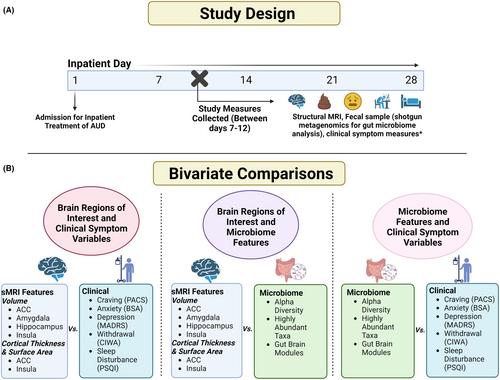Alcohol use disorder (AUD) is commonly associated with distressing psychological symptoms. Pathologic changes associated with AUD have been described in both the gut microbiome and brain, but the mechanisms underlying gut-brain signaling in individuals with AUD are unknown. This study examined associations among the gut microbiome, brain morphometry, and clinical symptoms in treatment-seeking individuals with AUD.
We performed a secondary analysis of data collected during inpatient treatment for AUD in subjects who provided gut microbiome samples and had structural brain magnetic resonance imaging (MRI; n = 16). Shotgun metagenomics sequencing was performed, and the morphometry of brain regions of interest was calculated. Clinical symptom severity was quantified using validated instruments. Gut-brain modules (GBMs) used to infer neuroactive signaling potential from the gut microbiome were generated in addition to microbiome features (e.g., alpha diversity and bacterial taxa abundance). Bivariate correlations were performed between MRI and clinical features, microbiome and clinical features, and MRI and microbiome features.
Amygdala volume was significantly associated with alpha diversity and the abundance of several bacteria including taxa classified to Blautia, Ruminococcus, Bacteroides, and Phocaeicola. There were moderate associations between amygdala volume and GBMs, including butyrate synthesis I, glutamate synthesis I, and GABA synthesis I & II, but these relationships were not significant after false discovery rate (FDR) correction. Other bacterial taxa with shared associations to MRI features and clinical symptoms included Escherichia coli and Prevotella copri.
We identified gut microbiome features associated with MRI morphometry and AUD-associated symptom severity. Given the small sample size and bivariate associations performed, these results require confirmation in larger samples and controls to provide meaningful clinical inferences. Nevertheless, these results will inform targeted future research on the role of the gut microbiome in gut-brain communication and how signaling may be altered in patients with AUD.


